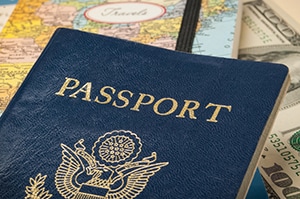International Travelers
Travelers to places where water and food may be unsafe and sanitation is poor are more likely to get a Shigella infection (shigellosis). They are also more likely to become sick with types of Shigella that are more difficult to treat. Shigella germs can spread to travelers through food, water (both drinking and recreational water), surfaces, and even other people. You can take steps before and during your trip to help prevent illness.
Protect Yourself While Traveling Abroad

Before your trip:
- Visit CDC’s Travelers’ Health website to learn about the health risks in countries you’ll visit and steps you can take to prevent getting sick.
During your trip:
- Keep your hands clean.
- Wash hands often with soap and water, especially at these key times:
- Before, during, and after preparing food
- Before and after eating food
- After using the bathroom
- After changing diapers or cleaning up a child who has used the bathroom
- Before and after caring for someone who is sick
- Wet hands with clean, running water and apply soap. Lather all surfaces of hands and scrub for at least 20 seconds. Rinse with clean, running water and dry with a clean towel or air dry them.
- If clean, running water and soap are not readily available, use an alcohol-based hand sanitizer that contains at least 60% alcohol. Remember, hand sanitizers may not be as effective if hands are visibly dirty or greasy.
- Wash hands often with soap and water, especially at these key times:
- Follow safe food and water practices.
- Avoiding unsafe food and water may be difficult when traveling abroad. In these instances, avoid eating and drinking raw fruits and vegetables, tap water, ice made from tap water, unpasteurized (raw) milk or dairy products, and items purchased from street vendors.
- These foods and drinks are usually safe: steaming-hot foods, fruits you peel yourself, bottled and canned processed drinks, and hot coffee or tea.
Learn about the health risks for diarrhea at your destination and know what steps you can take to prevent getting ill.
Should I Call the Doctor?
Travelers’ diarrhea is the most common travel-related illness. It can be caused by Shigella and many other harmful germs. Symptoms are usually mild and go away within several hours to days without antibiotics.
- If you have diarrhea,
- Drink plenty of fluids.
- Consider taking an over-the-counter medicine, such as Imodium or Pepto-Bismol, to decrease how much and how often you need to use the bathroom.
- Only take antibiotics if you have severe symptoms or are in a group of people who have a greater chance of severe illness. Take them exactly as the doctor prescribed.
- See a doctor or healthcare provider if you have severe symptoms, including:
- Bloody diarrhea.
- High fever (temperature over 102°F, measured in your mouth).
- Frequent vomiting that prevents keeping liquids down (which can lead to dehydration).
- Signs of dehydration, including little or no urination, a very dry mouth and throat, or feeling dizzy when standing up.
- Diarrhea that lasts more than 3 days.
- Ekdahl K & Andersson Y. The epidemiology of travel-associated shigellosis–regional risks, seasonality and serogroupsexternal icon. J Infect. 2005;51:222-9.
- Haley CC, Ong KL, Hedberg K, Cieslak PR, Scallan E, Marcus R, et al. Risk Factors for Sporadic Shigellosis, FoodNet 2005external icon. Foodborne Pathog. Dis. 2010;7(7):741-7.
- Kantele A, Lääveri T, Mero S, Vilkman K, Pakkanen SH, Ollgren J, Antikainen J, Kirveskari J. Antimicrobials increase travelers’ risk of colonization by extended-spectrum betalactamase-producing Enterobacteriaceae.external icon Clin Infect Dis. 2015;60(6):837-46.
- O’Donnell AT, Vieira AR, Huang JY, Whichard J, Cole D, Karp BE. Quinolone-resistant Salmonella enterica serotype Enteritidis infections associated with international travel.external icon Clin Infect Dis. 2014;59(9):e139-41.
- Riddle MS, Connor BA, Beeching NJ, DuPont HL, Hamer DH, Kozarsky PE, et al. Guidelines for the prevention and treatment of travelers’ diarrhea: a graded expert panel reportexternal icon. J Travel Med. 2017;24(Suppl 1):S2–S19.